Calling Dr. Death, Dead Man's Eyes, Weird Woman (1943, 1944, 1945)
Directed by: Reginald Le Borg
Written by: Brenda Weisberg, Dwight V. Babcock, Edward Dein, W. Scott Darling
Starring: Acquanetta, Anne Gwynne, Lon Chaney Jr., Patricia Morison
ON BLU-RAY 18TH JANUARY, from EUREKA ENTERTAINMENT
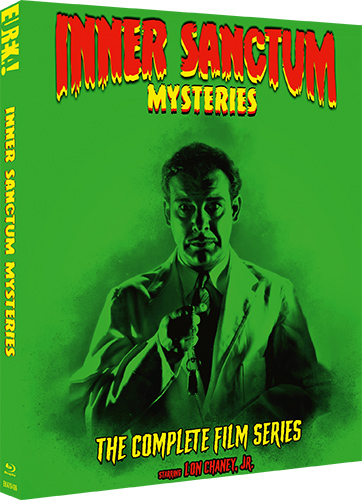
Inner Sanctum Mysteries began in 1930 as a series of novels which included ‘serious’ drama and romance but which quickly became associated with mystery and horror. The radio anthology series of the same name which started in 1941 was very popular, partly no doubt to the tongue-in-cheek introductions which inspired numerous successive hosts such as The Cryptkeeper, and led to a TV series in 1954. What we’re concerned with here though are the six films made by Universal starring the Wolf Man himself Lon Chaney Jr. I’d never seen any of them prior to receiving the two screener discs from Eureka Entertainment, but seeing as I’m not just a fan of Universal Horror but also things like the Sherlock Holmes series starring Basil Rathbone that came from the same studio, I was more than happy to check them out.
CALLING DR. DEATH [1943]
RUNNING TIME: 63 mins
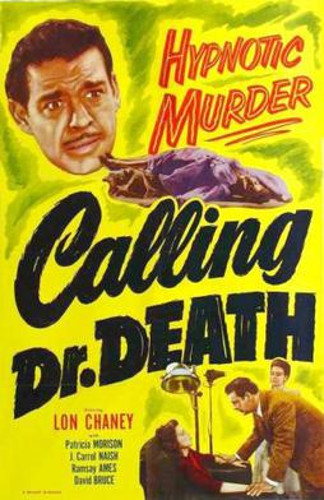
Respected neurologist Dr. Mark Steele treats his patients successfully with hypnosis, but is struggling to deal with the fact that his wire Maria is cheating on him and even dreams of killing her when she won’t consent to a divorce. He has a mental blackout and awakens to find that Maria has been murdered. Inspector Gregg understandably believes that Mark is responsible, and it sure looks that way….

I didn’t really know what to expect from the first entry but hoped that it would serve as enjoyable ‘B’ movie fare. Indeed that’s just what Calling Dr. Death is; a more than passable programmer that will certainly pass the time pleasantly if you enjoy your really old films as well as your new ones, but probably not one that will make a lasting impression despite some surprisingly stylish handling from director Reginald Le Borg [who surprisingly doesn’t seem to have much of note on his resume except for the best of the 1940’s mummy movies The Mummy’s Ghost and two more Inner Sanctum Mysteries] and the fact that its denouement was not at all guessable to me [let’s just say that I thought it was somebody else], the latter being very important in a mystery. There’s also a pretty good performance from Chaney who was always good at playing tormented characters who may have done very bad things. However, the thing feels very much like a much shorter radio drama padded out to feature length, while the gimmick of Chaney’s character voicing his thoughts was understandably deemed necessary on radio and no doubt worked in that format, but is rather intrusive in a movie, though it’s also done in the films to follow and was Chaney’s idea so I’m just going to have to try and get used to it. Nonetheless, despite being heavy on the talk and low on the action, it’s a tad more gripping than it may sound.
A head in a jar, its features distorted by the glass, introduces what’s to follow, finishing with this address to the viewer, “even you, without knowing, can commit murder”. I assume that the other films will commence in a similar fashion. The strange image of a light waving about in total darkness takes us into our hero [maybe] hypnotising his latest patient. She’s been unable to speak since a car accident, but while under hypnosis she says the name, “Frank”, who turns out to be her no good ex-boyfriend whom her parents strongly disapprove of. Now we get the first of those pesky voice overs as we learn that Mark has been married for two years and that he’s being cheated upon. These bits may have worked better with somebody else’s voice; Chaney can be a good actor but he doesn’t have a particularly good voice for voice overs and they soon do little but stop the pace dead. Still, we soon seriously dislike Maria very quickly when she makes her first appearance. She’s played by Ramsey Ames who’s much better here than in The Mummy’s Ghost where she visibly struggled with her interesting part. Maria refuses to give up her privileged position as a very successful doctor’s wife and intends to carry on doing just what she wants. When Mark goes to strangle her, we nearly want him to go through with it and are almost disappointed when the act turns out to be a dream. Mark does, though, also have a pretty secretary named Stella and the two clearly have the hots for each other though are restraining themselves. When Maria goes off on another one of her dirty weekends, Mark blacks out whilst driving and awakens to find that the lovely Maria has been killed by both a blow to the head and acid in the face. And one of his jacket buttons is by the body! Because of some of Chaney’s other roles, we really do think it could be him, so maybe we’re being given a double bluff? Yet Mark seems genuinely touched when the wheelchair-bound wife of Robert, one of the men that Maria was seeing, begs him to help her husband who is the other main suspect.
The climax predates the next year’s Spellbound in having hypnosis reveal murder secrets and is very stylishly handled with great touches like the fade from the close-up of a face to the first shot of the flashback taking ages and falling buildings. Seeing the police earlier outside Mark’s house from his point of view as he goes inside is another nice touch. Virgil Miller’s cinematography is a highlight throughout, be it typical film noir-style playing with shadows, or usage of Dutch angles and lots of slow zooms into foreheads when we’re going into somebody’s mind. It considerably enlivens what is otherwise a rather static piece which seems to back away from excitement even though the story has some potential in that department, chiefly consisting of dialogue sequences between Mark and Stella, and Mark and Inspector Gregg, one or two of the latter ones just repeating earlier beats and probably having been put in to stretch out the running time. Despite Chaney, it’s J. Carroll Naish who wins the acting honours as the dogged Gregg which means that one doesn’t really mind when he keeps on showing up to pester Mark Columbo-style. Screenwriter Edward Dein has still constructed a reasonable plot with only a couple of minor holes that I noticed. Calling Dr. Death is definitely good enough to make you want to see the rest of these cheapie programmers, though it won’t get you really excited to do this.
Rating: 









SPECIAL FEATURES
Audio commentary from screenwriter/film historian C. Courtney Joyner and Regina Le Borg [daughter of director Reginald Le Borg]
This relaxed, genial but very informative track did one thing for me; it made me want to check out some of Le Borg’s other work which is maybe better than I assumed. It seems that he was a genuine talent who never got the opportunity to rise out of the ‘B’ movie and TV ghetto. Joyner is obviously very respectful and praising of this director’s work what with his daughter being with him, but I learned about some films I’d never heard of, and we also learn that Gale Sondergaard was cast opposite Chaney for this and the next two films but was then dropped because of her political views, and how the producers of the radio show were ridiculously tight in what they let the filmmakers use. The disembodied head gave Regina nightmares as a kid.
Trailer
WEIRD WOMAN [1944]
RUNNING TIME: 63 mins
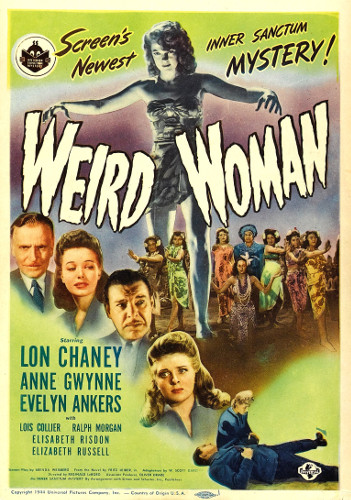
Professor Norman Reed returns from holiday in the South Seas with his new wife Paula, which meets with a unhappy reception from Nona, who’s convinced that she had a thing going with Norman, and starts scheming in revenge. Norman nonetheless has great success with the publication of his book ‘Superstition vs Reason and Fact’ and is mentioned as a contender for the head of the sociology department, things that Paula says were due to her magic. However, when the strictly rational Norman burns her charms, bad things begin to happen in the college….
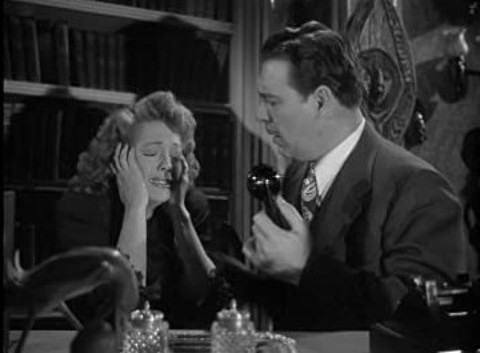
Not long into Weird Woman its story began to feel somewhat familiar to me until I eventually realised it was much like that of Night Of The Eagle [aka Burn Witch Burn], a pretty good horror from 1961 about witchcraft in a college. Both were based on the novel ‘Conjure Wife’ by Fritz Leiber, though the later film seems to be much closer to it. Partly perhaps due to the tiny budget, this version removes much of the witchcraft aspect [for example we don’t have any else in the college being witches] and makes it ambiguous as to whether the supernatural even exists at all. It seems quite influenced by the Val Lewton-produced horror films that were being made at the time by RKO; subtle, intelligent and hugely atmospheric efforts like Cat People and The Seventh Victim that I’ve also been reviewing of late for this website, though this effort is certainly not of their quality. While the return of Reginald Le Borg as director ensure that there’s some visual stylisation even if it’s nowhere near as interesting in that department as Calling Dr. Death, the potentially exciting subject matter is handled is a slightly humdrum fashion, and not enough is even made of the idea that everyone at this college seem to have designs good or bad on others, though a fair amount of plot is got through in an hour, with parts of Brenda Weisberg’s script having to be covered by montages, and the piece certainly passes the time pleasantly enough.
An atmospheric opening of Paula walking home as trees blow perhaps suggests a creepier film than the one we actually get, though us seeing Norman writing, “man’s struggle upward from his dark past is the struggle of reason against superstition” sums up his attitude to the supernatural better than a load of dialogue – though of course following this we have more darned voiceover. She tells him that she’s been asleep but he realises that she’s been lying; then we have a series of flashbacks. The South Seas locale is even more obviously a set than you’d expect from the period, they made little effort here. Norman steps into a voodoo ceremony [would they have them here?] and immediately falls for Laura whom he once met when she was a child and he was visiting her professor father. He has much success back home which Laura puts down to her magic, though he thinks her beliefs and her charms are silly. The college is a web of intrigue. Lona, whose father is the Dean, mistakenly thinks that her and Norman’s flirtation meant something, so she immediately takes a disliking to Laura. The younger Margaret also fancies Norman [Chaney must have enjoyed playing a guy with no less than three women after him even if he does his best to brush off two of them] and becomes his assistant, much to the chagrin of her jealous boyfriend David. The Dean has plagiarised his thesis from another source. One is certainly interested if hardly gripped, though when we see Lona scheming against Norman before our very eyes, it also becomes obvious pretty quickly that she’s the main cause of two deaths and things like phone calls to Laura playing death chants [honestly, this barely counts as a spoiler]. I was initially disappointed in this, though the favouring of suspense over surprise does eventually bring its own rewards, especially in the final act where we see guilt leading to undoing in the great EC Comics style.
Unlike the book and the later film version, there’s only one witch and it’s not really made clear if Laura really is one, or at least whether her magic works; certain things like wounds inflicted on Norman by angry tribespeople could just be chance. I like this type of ambiguity, though Anne Gwynne lacks either the acting chops or the mystery to pull her part off and consequently this leaves something of a hole in the proceedings. Fellow Universal scream queen Evelyn Ankers is Lona, and she seems to relish playing a villain for once, though the female side of things [nice to see as any female characters as male] is dominated by Lewton alumni Elisabeth Russell whose unique presence dominates every scene that her character is in even though she doesn’t get to do much that’s exciting. A moody though too short cemetery stalking is a definite highlight, though as with Calling Dr. Death the exciting potential of the tale is not fully capitalised on. Le Borg still manages to provide some unusual touches like characters in different locales making their points in the same shot, and there are some striking shots of faces superimposed on objects. It’s a little better than its predecessor, and certainly moves despite the reliance on dialogue, if not all outstanding in any way.
Rating: 









SPECIAL FEATURES
Audio commentary from author Justin Humphreys [The Dr. Phibes Companion] and Del Howison [Dark Delicacies: Original Tales of Terror and the Macabre]
The second talk track in this set is just as good as the first. Humphreys mostly leads and some to have more knowledge, though a clearly separate Howson supplies some choice additions. We learn much about the novel, that Chaney tore the jacket Phil Brown [David] was wearing which actually belonged to Brown, and that Ankers hated playing a villain even though it doesn’t show. Other things pointed out include how some aspects of the story would have to be altered if it was filmed today [what a restrictive climate we live in], and the nature of the film industry at the time. There’s the right level of appreciation for this programmer without becoming sickly fawning.
Trailer
DEAD MAN’S EYES [1945]
RUNNING TIME: 63 mins
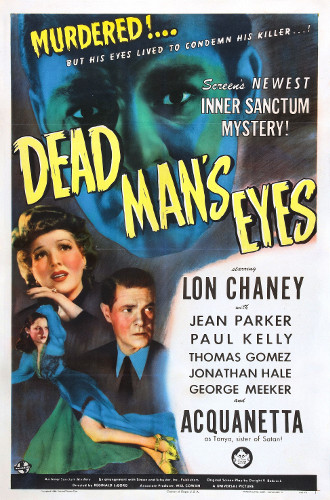
Painter Dave Stuart is just about to finish his masterpiece, of which he hopes he can get enough money to marry his fiancee Heather, when his jealous assistant/model Tanya mixes up the bottles in his bathroom so that, instead of eye fluid, he puts acid into his eyes and is blinded. He tells Heather he can’t marry her and becomes more dependent on Tanya to the latter’s delight, but an eye specialist explains that eyes from a dead man could be transplanted to him. Heather’s father, who still loves Dave like a son and wants his daughter to become happy with him, arranges in his will that as soon as he dies, Dave will get his eyes….
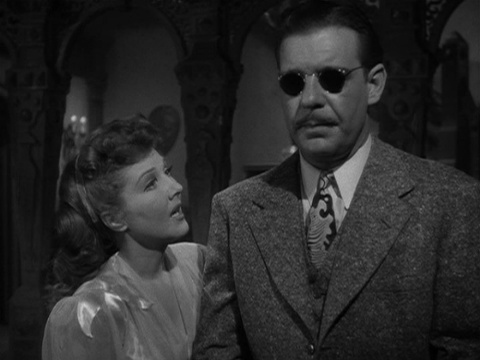
Watching Weird Woman, it came to me that Acquanetta would have been far suited for Anne Gwynne’s part until I remembered that the exotic-looking starlet of mysterious origin was a very poor actress. And now she’s in this one, and my memory was proved to be correct very early on. Dead Man’s Eyes has probably the simplest, most down to earth, premise out of the first three films in this series, yet in some respects it might be slightly superior to the other two. The fairly mild whodunnit doesn’t actually become a whodunnit until half way through, but, while the first two films didn’t really make the most out of their plots and material despite director Reginald Le Borg handling portions of it in a stylish fashion, this one doesn’t seem to suffer from that flaw, and even gets a little exciting in parts of the second half. Like Calling Dr. Death, it’s not that easy to guess who the murderer is, Dwight V. Babcock’s screenplay providing us with several equally plausible possibilities and playing fair too; I noticed no plot holes. I did though guess one revelation which I was convinced of but was still hoping the film would surprise me, and it’s a little disappointing that so far none of these films have gone so far as to present Lon Chaney as a murderer. I now think that none of the ones to follow will do so either, though this was no doubt one of the things that appealed to an already-typecast Chaney. I imagine that some reviews of these are saying that he’s miscast as these scientific or artistic types, and there are times when he doesn’t quite look the parts, but he tries gamely and mostly succeeds in pulling them off, all of the ones so far being helped by the fact that he has such a sad and worried face.
A fine opening shows us Dave, then moves left to show is his painting of Tanya, then Tanya, then Dave’s painting of his fiancee Heather. Tanya’s in love with Dave and Heather clearly notices this, though Dave seemingly chooses to be ignorant. The exchange, “Are you marrying your father or me”?, “Why, your father or course – with all his dough” is a prelude to their first kiss on screen in what overall has the best dialogue out of these three. Dave goes to put in his eye drops but instead it’s acid [it’s funny how so many people in films keep acid in their house], and his going blind is powerfully handled by close-ups of his eyes as Chaney pulls down his cheeks so we mainly see white, and his vision becoming distorted and getting darker. Of course our first suspicion is that Tanya didn’t move the bottles accidentally but did it on purpose, especially seeing how she relishes having Dave to herself after he’s dumped Heather, telling her that it’s because he doesn’t love her any more. But then there are other folk hanging around. Alan Bittaker, a psychiatrist and Dave’s closest friend, has a passion for Tanya while Heather is wanted by Nick Philips, whom her father Stanley Hayden dislikes. He likes Dave though, so he puts in his will that Dave can have his eyes. Such an operation is apparently possible, though it’s not certain that sight will be regained. Wanting to apologise for dumping his daughter, Dave visits Stanley at his residence, only to be have Heather walk in and find him standing over her father’s dead body. He’s been bludgeoned to death by something, and of course Dave is the chief suspect to the police though not to us. Dave has the operation but still can’t see. Nonetheless, he sets out to clear his name, and thinks that a nail he found by the body could be the key. The pace certainly speeds up and we even get another murder, a fairly good version of the familiar set-up of someone on the phone about to spill some beans before being cut off permanently by a shadow approaching her from behind.
The operation is an especially well handled sequence, a montage of well chosen shots while the shadow of a huge pendulum swings back and forth in the foreground. Chaney, whose voice over first appears later than usual, certainly convinces as a blind person and we care enough to want his character’s sight to heal which we’re told is possible. Acquanetta just seems like she’s reading lines off cue cards though Jean Parker is fine as Heather. Thomas Gomez’s Captain Grury often turns up to bother Dave in what is a clear reprise of J. Carrol Naish’s similar character doing the same in Weird Woman; Naish did it better but Gomez is fine. There’s one particularly well handled scene between the two near the end where Dave sinks to the ground half way through as Gomez has the upper hand in the conversation. Le Borg seems to be very focused on character positioning throughout while cinematographer Paul Ivano even indulges in some deep focus photography and doesn’t make us miss the first two film’s Virgil Miller too much. Le Borg didn’t make any more of these and I do wonder if the successive films will suffer from the lack of his touch. Dead Man’s Eyes is maybe the least interesting of the first three Inner Sanctum features but may be the best one too.
Rating: 









SPECIAL FEATURES
Trailer
DISC ONE SPECIAL FEATURES
Kim Newman on The Inner Sanctum Mysteries – New interview with journalist, film critic, and fiction writer Kim Newman [30 mins]
Eureka have carried over most of the special features that were on Mill Creek’s Region ‘A’ set, though a few have been added and some subtracted. This new chat from Newman begins with a major spoiler alert, and rightfully so as it gives away some stuff including something very important regarding one particular film. Thank goodness I watched all the films first. Newman, in that bizarre mock film poster blazer that seems to be his fashion these days, appeara to really relish talking about these films, and indeed the general subject of old-time mystery radio play and ‘B’ movie mystery films. We learn that Inner Sanctum Mysteries was only one of many similar programmes of the time, hear a bit about the radio series, and have him claim that Boris Karloff or Bela Lugosi would not have been as good as Chaney in the lead despite his reputation as a ‘second tier’ horror star in what is a nice defense of the actor. Newman sometimes goes off on slight tangents, but isn’t it fun to hear that, for example, scripts were often re-used so that different movie detectives often sold the same case?
This is the Inner Sanctum: Making a Universal Mystery Series [32 mins]
Despite supposedly running 55 mins, this only runs 32, and only covers the first four films in the six-part series, rather suddenly ending in the process. Did it have to be edited for legal reasons? Also on the Mill Creek where it also appears to have been cut judging by the sources I checked out, it’s still a good run through, and tells us that the screenplay for Calling Dr. Death had been lying around for ages [which is odd as it seems like a short film extended], refutes an old claim that Chaney’s voice-overs were added because he had trouble speaking some lines, and reveals that the person playing the killer in Dead Man’s Eyes actually killed someone in real life and went to prison! While not actually revealing murderers this time, I’d still recommend that you watch it after you’ve seen all the films.
Inner Sanctum Mysteries: Radio Episodes – A selection of episodes from the original radio series
These also weren’t on the Mill Creek. Replete with short breaks featuring host Raymond Edward Johnson providing tongue in cheek commentary and advertisements for Carter’s Little Liver Pills, they’re a real fun listen, and much like the films; mysteries with horror elements.
The Amazing Death of Mrs. Puttnam [25 mins]
The police receive a phone call from a woman who sounds like she’s being murdered. Two cops, whose banter is so typical of the time, arrive at a house which you know is going to full of secrets in 20 minutes and are told that a woman did die, but it happened two hours ago and from natural causes. The reasonable mystery plot even features the archetypal device of a will.
The Black Seagull [29 mins]
The great Peter Lorre stars in this one and his wonderful voice adds greatly to the Edgar Allan Poe feel. His character finds his wife dying on a boat. “I’ll come back” she says, and she does seem to come back to him, but is it for real or only in his head? An ambiguous ending adds to the rather eerie effect of the only one of these episodes which may possibly exist in the world of the supernatural.
The Skull That Walked [30 mins]
A skull is unearthed but seems to move. This time the resolution is of a typical dastardly plot, though a faint suggestion of more exists. This rather average story is followed by the first part of another entitled Death In The Daytime, in which a man is mysteriously murdered in a busy bar at the same time as a criminal dies in the electric chair. With some humour but also much mystery, I was enjoying this so much it’s disappointing that I may never know the outcome.
‘INNER SANCTUM MYSTERIES’ SPECIAL FEATURES
O-Card Slipcase
High Definition Blu-ray (1080p) presentations of all six films
These first three films look excellent on Eureka’s Blu-ray despite being of very low budget origin; one can really appreciate how well they were shot despite being made over around two weeks. There seems to be no digital sharpening and grain looks excellently managed.
Uncompressed LPCM monaural audio tracks
Optional English SDH subtitles
A collector’s booklet featuring new writing on the series by Craig Ian Mann
Check out the review of DISC 2





Be the first to comment